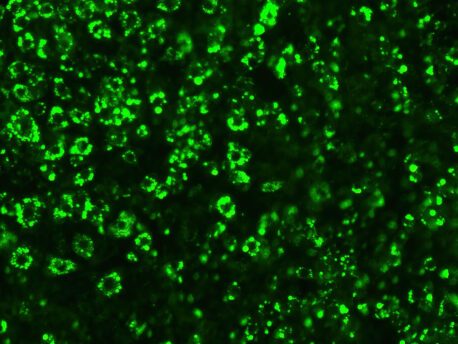
August 7, 2025
Salk Institute researchers identify dozens of microproteins involved in fat storage, offering new potential drug targets for future obesity therapeutics
Salk Institute researchers identify dozens of microproteins involved in fat storage, offering new potential drug targets for future obesity therapeutics
LA JOLLA—The obesity rate has more than doubled in the last 30 years, affecting more than one billion people worldwide. This prevalent condition is also linked to other metabolic disorders, including type 2 diabetes, cardiovascular diseases, chronic kidney disease, and cancers. Current treatment options include lifestyle interventions, bariatric surgery, and GLP-1 drugs like Ozempic or Wegovy, but many patients struggle to access or complete these treatments or to maintain their weight loss afterwards.
Salk Institute scientists are looking for a new treatment strategy in microproteins, an understudied class of molecules found throughout the body that play roles in both health and disease. In a new study, the researchers screened thousands of fat cell genes using CRISPR gene editing to find dozens of genes that likely code for microproteins—one of which they confirmed—that regulate either fat cell proliferation or lipid accumulation.

The findings, published in Proceedings of the National Academy of Sciences on August 07, 2025, identify new microproteins that could potentially serve as drug targets to treat obesity and other metabolic disorders. The study also showcases the value of CRISPR screening in future microprotein discovery.
“CRISPR screening is extremely effective at finding important factors in obesity and metabolism that could become therapeutic targets,” says senior author Alan Saghatelian, a professor and holder of the Dr. Frederik Paulsen Chair at Salk. “These new screening technologies are allowing us to reveal a whole new level of biological regulation driven by microproteins. The more we screen, the more disease-associated microproteins we find, and the more potential targets we have for future drug development.”
Current obesity and metabolic disorder therapeutics
When our energy consumption exceeds our energy expenditure, fat cells can grow in both size and number. Fat cells store the excess energy in the form of fatty molecules called lipids. But while some excess storage is manageable, too much can cause fat deposits to accumulate around the body—leading to whole-body inflammation and organ dysfunction.
Many factors regulate this complex energy storage system. The problem is, how do we find them all, and how do we filter for factors that may make good therapeutic candidates?
This has been a longstanding question for Salk scientists. In fact, Salk Professor Ronald Evans has been working on it for decades. Evans is an expert on PPAR gamma, a key regulator of fat cell development and a potent target for treating diabetes. Several drugs have been developed to target PPAR gamma to treat obesity, but they resulted in side effects like weight gain and bone loss. An ideal PPAR gamma-based obesity therapeutic has yet to hit the market.
When PPAR gamma drugs fell short, GLP-1 drugs entered the scene. GLP-1 is a peptide small enough to be considered a microprotein, and it serves as a blood sugar and appetite regulator. But, like PPAR gamma, GLP-1 drugs have their own shortcomings, such as muscle loss and nausea. Nonetheless, the popularity of GLP-1 drugs demonstrates a promising future for microprotein drugs in the obesity therapeutic space.
Saghatelian’s team is now searching for the next microprotein therapeutic with new genetic tools that bring microproteins out of the “dark.” For many years, long stretches of the genome have been considered “junk” and thus left unexplored. But recent technological advances have allowed scientists to look at these dark sections and find a hidden world of microproteins—in turn, expanding protein libraries by 10 to 30 percent.
In particular, the Salk team is using innovative CRISPR screening to scour the “dark” for possible microproteins. This approach is enabling the simultaneous discovery of thousands of potential microproteins involved in lipid storage and fat cell biology, accelerating the search for the next PPAR gamma or GLP-1 drug.
How CRISPR screening accelerates the search for microproteins
CRISPR screens work by cutting out genes of interest in cells and observing whether the cell thrives or dies without them. From these results, scientists can determine the importance and function of specific genes. In this case, the Salk team was interested in genes that may code for microproteins involved in fat cell differentiation or proliferation.

“We wanted to know if there was anything we had been missing in all these years of research into the body’s metabolic processes,” says first author Victor Pai, a postdoctoral researcher in Saghatelian’s lab. “And CRISPR allows us to pick out interesting and functional genes that specifically impact lipid accumulation and fat cell development.”
This latest research follows up on a prior study from Saghatelian’s lab. The previous study identified thousands of potential microproteins by analyzing microprotein-coding RNA strands derived from mouse fat tissues. These microprotein-coding RNA strands were filed away to await investigation into their functions.
The new study first expanded this collection to include additional microproteins identified from a pre-fat cell model. Notably, this new model captures the differentiation process from pre-fat cell to a fully mature fat cell. Next, the researchers screened the cell model with CRISPR to determine how many of these potential microproteins were involved in fat cell differentiation or proliferation.
“We’re not the first to screen for microproteins with CRISPR,” adds Pai, “but we’re the first to look for microproteins involved in fat cell proliferation. This is a huge step for metabolism and obesity research.”
Microproteins of interest and next steps
Using their mouse model and CRISPR screening approach, the team identified microproteins that may be involved in fat cell biology. They then narrowed the pool even further with another experiment to create a shortlist of 38 potential microproteins involved in lipid droplet formation—which indicates increasing fat storage—during fat cell differentiation.
At this point, the shortlisted microproteins were all still “potential” microproteins. This is because the genetic screening finds genes that may code for microproteins, rather than finding the microproteins themselves. While this approach is a helpful workaround to finding microproteins that are otherwise so small they elude capture, it also means that the screened microproteins require further testing to confirm whether they are functional.
And that’s what the Salk team did next. They picked several of the shortlisted microproteins to test and were able to verify one. Pai hypothesizes this new microprotein, called Adipocyte-smORF-1183, influences lipid droplet formation in fat cells (also known as adipocytes).
Verification of Adipocyte-smORF-1183 is an exciting step toward identifying more microproteins involved in lipid accumulation and fat cell regulation in obesity. It also verifies that CRISPR is an effective tool for finding microproteins involved in fat cell biology, obesity, and metabolism.
“That’s the goal of research, right?” says Saghatelian. “You keep going. It’s a constant process of improvement as we establish better technology and better workflows to enhance discovery and, eventually, therapeutic outcomes down the line.”
Next, the researchers will repeat the study with human fat cells. They also hope their success inspires others to use CRISPR screenings to continue bringing microproteins out from the dark—like Adipocyte-smORF-1183, which until now, was considered an unimportant bit of “junk” DNA.
Further validation or screening of new cell libraries will expand the list of potential drug candidates, setting the stage for the new-and-improved obesity and metabolic disorder therapeutics of the future.
Other authors include Hazel Shan, Cynthia Donaldson, Joan Vaughan, Eduardo V. De Souza, Carolyn O’Connor, and Michelle Liem of Salk; and Antonio Pinto and Jolene Diedrich of Scripps Research Institute.
The work was supported by the National Institutes of Health (F32 DK132927, RC2 DK129961, R01 DK106210, R01 GM102491, RF1 AG086547, NCI Cancer Center P30 014195, S10- OD023689, and S10-OD034268), Ferring Foundation, Clayton Foundation, and Larry and Carol Greenfield Technology Fund.
DOI: https://doi.org/10.1073/pnas.2506534122
JOURNAL
Proceedings of the National Academy of Sciences
TITLE
CRISPR-Cas9 Screening Reveals Microproteins Regulating Adipocyte Proliferation and Lipid Metabolism
AUTHORS
Victor J. Pai, Hazel Shan, Cynthia Donaldson, Joan Vaughan, Eduardo V. De Souza, Carolyn O’Connor, Michelle Liem, Antonio Pinto, Jolene Diedrich, and Alan Saghatelian
Office of Communications
Tel: (858) 453-4100
press@salk.edu
Unlocking the secrets of life itself is the driving force behind the Salk Institute. Our team of world-class, award-winning scientists pushes the boundaries of knowledge in areas such as neuroscience, cancer research, aging, immunobiology, plant biology, computational biology and more. Founded by Jonas Salk, developer of the first safe and effective polio vaccine, the Institute is an independent, nonprofit research organization and architectural landmark: small by choice, intimate by nature, and fearless in the face of any challenge.